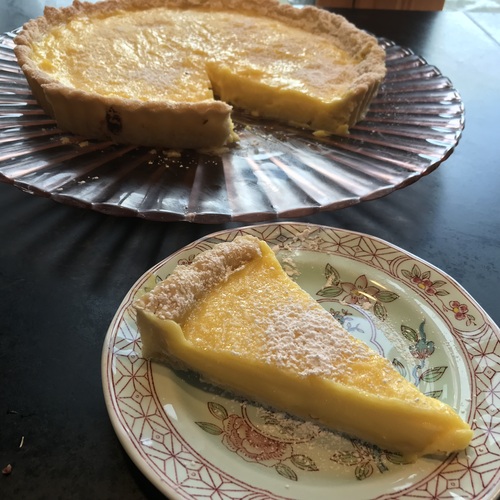BELLOWS FALLS — I grew up in a family of lemon lovers - the more tart, the better. After a heavy holiday meal, a little slice of a zesty lemon tart is a perfect finish.
One of my mother's favorite tarts to make was her sister's lemon tart, only Mom always topped her version with meringue, probably because my aunt never did so with hers, and they were a bit competitive in the kitchen.
I've simplified my aunt's recipe and reduced the sugar, so the lemon curd filling is quite tart. But, as with everything else, I tell folks: If you like it sweeter, add more sugar! You can add up to {1/3} cup.
I used an all-butter crust here, but any favorite crust will do - even a packaged one, if you are pressed for time.
This recipe is for the holidays, and I didn't even try to make it less decadent. It just wouldn't be worth it. It's rich, and you only need a very small slice!
Now, pucker up!
Aunt Jeanette's Luscious Lemon Tart
Preheat your oven to 350 F and place the rack in the middle of oven. Have your baked 10-inch tart crust ready for action.
Zest:
¶3 large lemons (you'll need more for juice)
Squeeze the zested lemons for the juice, and combine with the juice from as many lemons as you need for 1{1/4} cups. Put the juice and zest in a heavy-bottomed saucepan.
In that same saucepan, add:
¶4 large eggs
¶4 egg yolks (use the whites for another purpose)
¶1{1/2} sticks unsalted butter, cubed
¶Large pinch of salt
¶{2/3} cup superfine sugar
Place over medium heat. Once the butter has melted, keep stirring until the mixture is thickened; whisk as needed to keep everything smooth.
To determine if it's ready, make sure it is the consistency of a thick pudding. While it won't actually be boiling, you should see big plops of curd bubbles breaking through.
Press as much of the curd as you can through a wire mesh strainer, and don't forget to scrape what is left on the bottom of the sieve.
Pour the curd into your baked shell, and smooth it flat. Bake for about 10 minutes, just to finish setting the tart.
Cool completely - overnight is best - with a thin film of plastic wrap set directly on top to prevent a skin from forming. When you're ready to serve it, sprinkle the tart with powdered sugar.
You can also top this tart with whipped cream, or you can use it as a base for a luscious lemon meringue pie (which you can make using those reserved egg whites).
Basic Pastry
This recipe (originally published in the Oct. 7, 2020 issue) makes two crusts, and you can freeze the extra. Have all your ingredients, even the flour, well-chilled before you start.
In a food processor fitted with a steel blade, combine:
¶3 cups pastry or all-purpose flour
¶1 tsp. Salt
Pulse a few times to combine, then add:
¶{1/2} cup unsalted butter, cubed and well chilled
¶{1/2} cup shortening (or solid coconut oil, or use another {1/2} cup of butter), chilled
Pulse quickly 6 or 7 times. The dough will look like coarse sand with some big clumps of butter in it. This is what you want.
In a liquid measuring cup with a pouring spout, add:
¶{1/2} cup ice water (remove ice cubes)
¶1 Tbsp. lemon juice or white vinegar
Drizzle almost all of the mixture over the dough and pulse again, quickly, six or seven times. Remove a little clump and squeeze it: if it sticks together easily, your dough is ready, even if it still looks unmixed. If it falls apart, add the rest of the water and pulse once or twice. The dough will still look craggy and unmixed.
Pour the whole thing out on a lightly floured counter and very gently press the dough together, bringing up the loose sides.
If you have hot hands, keep your warm fingers off the dough by placing it on a large sheet of plastic wrap, gathering up the sides, and pressing the edges into the dough.
Continue until the dough forms a mass. Cut in two, and gently form into discs.
Your dough should still have visible bits of butter throughout. As it heats up in the oven, the water in the butter will create steam, which will add to the flakiness.
Wrap the discs of dough and place them in the refrigerator for 30 minutes. This is an important step, as the gluten in the flour will need to relax and the flour will need to absorb the water.
You can freeze the surplus dough at this point.
This Special section was submitted to The Commons.
